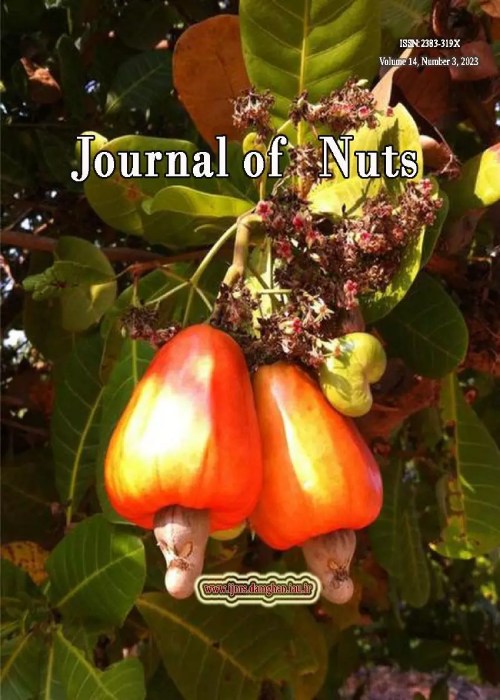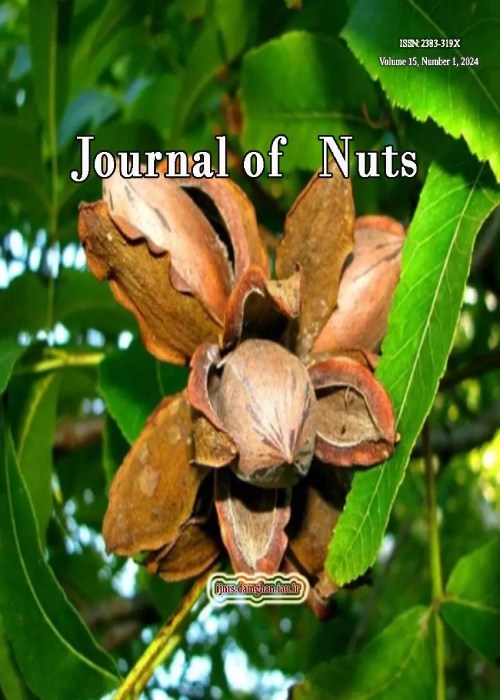فهرست مطالب

Journal of Nuts
Volume:14 Issue: 4, Autumn 2023
- تاریخ انتشار: 1402/09/10
- تعداد عناوین: 6
-
-
Pages 239-250Pines are a family of coniferous seed plants with over 100 species, variations, and hybrids. The seeds found in pine cones are known as pine nuts, and a typical cone can carry between 50 and 100 seeds, depending on the year and the species of the pine tree. Each seed has a hard outer shell that encases the kernel. Pine seeds that are large enough to harvest are produced by about 20 species of pine trees. The pine nut is one of the most valuable nuts in the world, and the stone pine is among the oldest fruit trees, as evidenced by archaeological finds dating back to pre-Christian times. Pine nuts, as part of the Mediterranean diet, help lower the risk of several types of cancers, type 2 diabetes, and cardiovascular disease. Pine nuts are in high demand due to their high culinary and nutritional value. In this study, Inductively Coupled Plasma-Optical Emission Spectroscopy (ICP-OES) was used to analyze the minerals of Pinus species growing in various parts of Egypt, including Torrey pine, Italian stone pine, Johann's pine, Coulter pine, Mexican pinyon, Swiss stone pine, and Armand pine. These pines were found to have different minerals, except for Coulter pine, which had no Al or Na. Pine nuts cultivated in Egypt are a rich source of Zn, P, Mn, Mg, and Cu, matching or exceeding the recommended daily intake (RDI) for such minerals while providing between 38% and 84% of the RDI for Fe. In comparison to other types of tree nuts that are usually eaten, pine nuts that are cultivated in Egypt provide a superb supply of nutrients.Keywords: Dietary minerals, mineral content, Nut industry, Pinus species
-
Pages 251-261Pistachio is one of the valuable export products very susceptible to infection by A. flavus. The present study aimed to investigate the effect of coating fresh pistachio with hydrocolloid methylcellulose on aflatoxin amount during storage. In this study, pistachio seeds from the Abbasali cultivar were used. Methylcellulose solution with different concentrations (0.1%, 0.5%, 1%, and 2%) was prepared and a coating of this hydrochloride was created by immersing methylcellulose on pistachio samples. The coated samples and the control sample (uncoated) were kept in an incubator at a temperature of 25°C for 3 months. In the investigation of the impact of various methylcellulose concentrations in the composition of the pistachio kernel coating, on the inhibition rate of this micro colloid on the production of total aflatoxin and B1, B2, G1, and G2 aflatoxin which was measured by HPLC, showed that concentrations of 0.1% and 0.5% reduced total aflatoxin production significantly, it increased about 3.5 times after three months of storage. Also after 3 months of storage, aflatoxin B1, B2, G1, G2 in the samples coated by 0.5% and 0.1% methylcellulose was decreased to undetectable toxin production. Also, evaluation of moisture content revealed that the pistachio seed coated with methylcellulose had the highest moisture content at 2% and the lowest at 0.1% and 0.5% of the control samples.Keywords: Aflatoxin, Coating, Methylcellulose, Pistachio
-
Pages 263-272To investigate the use of chestnut shell powder, an agricultural industry by-product, as a value-added ingredient for enhancing the nutritional profile of brioche bread, this study examined different factors such as rheological, chemical, volumetric, color properties. The study tested three levels of chestnut shell powder: 5%, 8%, and 10%. A positive correlation between the addition of chestnut shell powder and farinographic characteristics was found. Specifically, the samples containing chestnut shell powder showed higher levels of water absorption (increased by 5-10%), dough expansion time, dough resistance, and farinograph quality number (FQN) compared to the control sample without chestnut shell powder. The extensograph test showed an increase in most of the extensograph characteristics, except for the dough stretchability factor, in the samples containing chestnut shell powder compared to the control sample. In terms of colorimetric properties, the treatment with 10% chestnut shell powder had the lowest lightness score (41.8), while the control sample had the highest score (52.5). The values of redness and yellowness factors were also reported to be the lowest in the control (3.2, 13.9) and the highest in the E3 sample (5.7, 25.2). The chemical test results showed that treatment E3 had the highest values of moisture, ash, fiber, fat, and protein, while the control treatment had the lowest values. Overall, this study suggests that adding chestnut shell powder to brioche bread can enhance its quality and nutritional properties.Keywords: Ecotype, Chestnut shell, Dough samples, Extensograph test, Farinograph test
-
Pages 273-282Application of sulfur to control the common pistachio psylla has been nowadays popular. The psylla is one of the main pistachios’ pests. Aspergillus flavus, the most important aflatoxin producer, has a strong impact in the mycoflora of pistachio orchards. The present study has been conducted to determine the effects of sulfur on A. flavus. Therefore, a toxigenic A. flavus strain was cultured on potato dextrose agar (PDA) medium, and the effects of mineral sulfur, refinery sulfur and sodium metabisulfite were closely monitored on fungal mycelial dry weight, germination of spores, germ tube and mycelium germination. The Fungal parameters measurement for sulfur vapor exposure and sulfur addition to the culture medium declared no significant effect on the growth of A. flavus mycelium in the direct addition. But sulfur in liquid medium as well as in high concentrations caused mycelial dry weight loss. Importantly, the sublimation of 0, 0.5, 1, 2, 5, 10, 25 and 50 gm-3 from the refinery sulfur, prevented completely the growth of germinated spores and mycelial. Significantly, the complete inhibition of spore germination was observed at a concentration level of 2 g m-3 and also sodium metabisulfite prevented the growth of A. flavus at a concentration of 15 g l-1 culture medium. The sulfur usage in culture medium declared no inhibition of A. flavus growth, but at high concentrations in liquid medium, it reduced mycelial dry weight. Therefore, it is found that the sulfur application in any kind to control of psylla would not probably effect significantly on the aflatoxigenic A. flavus.Keywords: Food Safety, Fungal growth, Mycelium weight, Mycotoxin, sporulation
-
Pages 283-292Pecan fruit, also known as pecan nut, is a type of nut that is popular for its rich, buttery flavor and crunchy texture. This research aimed to investigate the effects of spraying boric acid and zinc sulfate on the physical traits of pecan fruit in Erbil, Iraq. The experiment was conducted in the spring of 2022 using a completely randomized block design with three levels of boric acid (0, 1500, and 3000 mg l-1) and three levels of zinc sulfate (0, 2500, and 5000 mg l-1). The spraying was carried out before the flower buds opened, and at the time of harvesting, various physical characteristics of the fruit were measured, including length, width, weight, kernel weight, percentage of hull, percentage of shell, percentage of kernel, and absorption of elements in leaves and nuts. The results showed that spraying with boric acid (3000 mg l-1) and zinc sulfate (5000 mg l-1) had the greatest effect on increasing fruit length, while the fruit width was highest in the zinc treatment (5000 mg l-1), and it was significant compared to the control treatment. None of the treatments had a significant effect on fruit weight, kernel weight, percentage of shell, and percentage of hull skin. Moreover, the spraying significantly increased the amount of boron and zinc elements in leaves and nuts. Therefore, it can be concluded that spraying with boric acid and zinc sulfate can be an effective method to improve the physical characteristics of pecan nuts and increase the absorption of essential elements in leaves and nuts.Keywords: Foliar application, Pecan nut, Physical traits, Zinc
-
Pages 293-303
Salinity is a significant ecological stressor that reduces agricultural productivity and sustainability in arid and semiarid regions by impacting germination rates, delaying the start of germination, and ultimately delaying seedling establishment. Globally, salt has a negative impact on agricultural yield, because most of cultivated plants are salt-sensitive glycophytes. Salt stress also influences seed germination and seedling establishment in three different ways: ion toxicity, oxidative stress, and osmotic stress. Four groundnut genotypes (KDG-128, GG-20, GJG-31, and TG-37A) were examined for their phenotypic variation and the impact of salt content on germination, growth, and yield metrics. Different KCl and Na2SO4 solution concentrations were used in saline treatments. Salinity had a serious influence on germination, according to the results. Finding salt tolerance genotypes was the main goal of this study. The TG-37A and GJG-31 genotypes were proven to be salt-tolerant based on the germination %, but the KDG-128 genotype is a moderately salt-tolerant genotype and the GG-20 genotype is a salt-susceptible genotype. Genotypes for tolerance are beneficial in the field of agriculture, and the findings unambiguously show that salinity cannot restrict plant growth and development.
Keywords: Agricultural Productivity, Salt- sensitivity, Glycophytes, Salt tolerance genotypes, Salt-susceptible genotype


